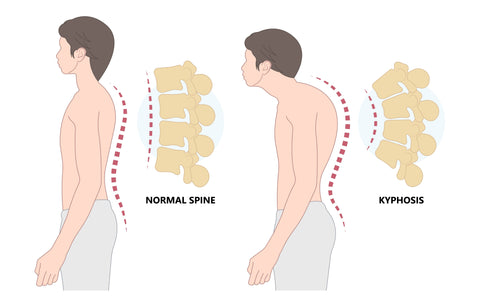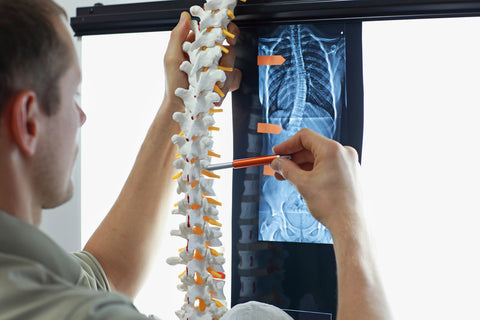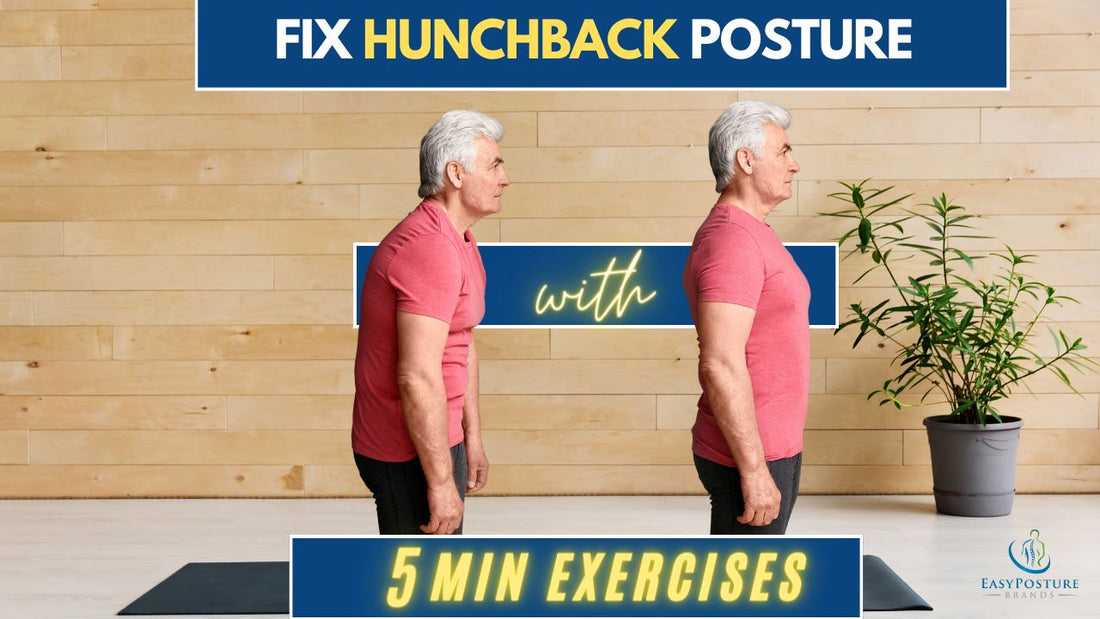Do you slouch? Have you ever felt like your head is pushing too far forwards?
Are you on the computer for long periods of time and unable to stay upright?
If you answered yes to any of these questions, then you may be exhibiting hunchback posture, or what some refer to it as "nerd neck".
In this article, we will discuss what hunchback posture is, signs and symptoms, and treatment methods.
What is hunchback posture?

Kyphosis, or hunchback, refers to an excessive forward curvature of the spine, typically in the thoracic region.
This results in a forward head, rounded shoulders, and an overall “slouched” posture presentation. It can cause pain or breathing problems if the kyphosis is severe enough.
Sign and Symptoms of Hunchback Posture
- Rounded shoulders
- Hump at the base of the neck/shoulders
- Tight hamstrings
- Numbness or tingling into upper or lower extremities
- Pain between the shoulder blades
- Stiffness of the neck, arms, and upper back
- Weakness of the neck, arms, and upper back
In extreme cases, people may experience balance issues, bladder or bowel incontinence, shortness of breath, or difficulty breathing.
Causes of Hunchback (Nerd Neck)
Hunchback can be caused by a number of things including:
- Poor posture
- Structural abnormalities of the spine
- Abnormal bone growth
- Injury to the spine
- Age
How is it diagnosed?
Physical exams and imaging studies are usually used to diagnosis kyphosis. Health screenings performed in schools can catch spine abnormalities like kyphosis and scoliosis and allow for earlier treatments.

Risk Factors
Some risk factors for the development of hunchback include:
- Growth spurts
- Aging
- Weakness of the postural muscles
- Activities involving prolonged sitting
A kyphotic posture may also be congenital and present at birth.
Can kyphosis be reversed?
Depending on the underlying reason for the development of hunchback, yes it can be reversed.
This condition is treated by physical therapy, pain medications, back braces, and/or surgery. Many people with hunchback benefit from strengthening and stretching appropriate muscle groups and can avoid more invasive procedures.
Read Related: Top 7 Back Braces for Lower Back Pain
Does hunchback cause pain or discomfort?
Yes, in many cases, hunchback posture can cause neck, shoulder, and mid-low back pain as well as symptoms into the extremities. Pain level varies depending on the severity of the kyphosis.
How to Prevent or Correct Hunchback Posture
To reduce the risk of developing hunchback, it is important to use things that facilitate proper posture and support your body’s natural curvature.
For example, supportive office chairs, back and bottom cushions, standing desks, ergonomic mice and keyboards are all items that will help reduce the risk of developing hunchback posture.
Back supports like the one pictured below are excellent providing spinal support to keep your spine properly aligned. It can be used at a desk or in the car, whenever you feel the need for a little extra support.

Hunchback (Nerd Neck) Exercises
In addition to these ergonomic solutions, it is important to strengthen the muscle in your neck and mid-back region as well.
When these muscle groups are strong and stretched out, it is easier to maintain a good sitting or standing position.
Chin tucks, scapular retractions, rows, doorway stretches, and open books are just some of the most effective exercises to target these important muscle groups.
Fix Hunchback Posture with 5 Exercises (Watch Video Above):
- Chin Tucks
- Scapular retractions
- Rows
- Doorway Stretch
- Open Books
Step by Step Instructions for Each Hunchback Exercise
Chin Tucks
- Begin in a seated position with your feet flat on the floor. Make sure you are sitting upright before beginning this exercise.
- Imagine you are tucking your chin down to create a double chin. This should be a very small movement. Hold for 3-5 seconds before you relax.
- Repeat up to 20 times.
- This exercise helps strengthen your deep neck muscles which provide support to your head and shoulders throughout the day.

Scapular Retractions
- Begin in a seated position with your feet flat on the floor. Make sure you are sitting upright before beginning this exercise.
- Imagine you are pulling your shoulder blades back and down like you are trying to pinch a pencil between them. Your shoulders should move away from your ears allowing for a small chest stretch and a pulling sensation between your shoulders.
- Hold this position for 3-5 seconds before relaxing. Repeat up to 20 times.
- This exercise targets your middle trap and rhomboids which help prevent shoulder rounding.
Rows
- Begin this exercise in standing with a resistance band tied to a door at chest height.
- Hold one end of the band in each hand and take a step away from the door so your arms are slightly extended.
- Pull your elbows straight back towards your rib cage while trying to squeeze your shoulder blades together like in the previous exercise. You should feel your shoulders moving away from your ears.
- Hold this position for 2-3 seconds before your relax. Repeat 20 times.
- This exercise works the same muscle group as the prvious exercise but provides a bit of resistance to the movement. Resistance is an excellent way to challenge the strength and power of your muscles.
Doorway Stretch
- Begin this exercise by standing in a doorway with your forearm rested on the door frame. Make sure your elbow is slightly below 90 degrees.
- Slightly turn your body away from where your arm is rested on the door frame until you feel a stretch in your chest.
- Hold for 30 seconds and then relax. Repeat on both sides 3 times.
- This exercise helps stretch your pectoralis muscles which often become shortened or tight with hunchback posture.

Open Book Stretch
- Begin this exercise by lying on your side with your knees bent 90 degrees with palms stacked.
- Slowly reach your top arm up and out rotating to the opposite side until the stretch is felt in the chest, shoulder, and upper back region.
- Hold this position for 3-5 seconds before returning to the starting position. Repeat 10 times on each side.
- This exercise helps maintain the mobility of your thoracic spine. It will help stretch the muscles that often get tight in hunchback posture.

Lifestyle changes
Lifestyle changes like developing a regular stretching/strengthening routine, carrying heavy items in a sturdy backpack instead of off one shoulder, and maintaining a healthy weight can all reduce the risk of developing hunchback posture.
It is important to remain mindful of prolonged positioning and to move regularly.
Hunchback posture is caused by numerous things including poor posture, structural abnormalities, and age-related changes to the spine.
It can often be treated and prevented by exercise and the use of ergonomic devices to help maintain proper sitting posture.
In more extreme cases, back braces or surgery may be involved. Maintaining a healthy lifestyle and regular stretching/strengthening routine can help prevent the development of hunchback posture.
If you think you are suffering from kyphosis, consider consulting a healthcare professional to determine what treatment methods would be the best for you.
Resources:
Cleveland Clinic. (2023, October 11). Kyphosis: What is it?. Cleveland Clinic. https://my.clevelandclinic.org/health/diseases/17671-kyphosis
National Library of Medicine. (2017, July 15). Reversing thoracic hyperkyphosis: a case report featuring mirror image® thoracic extension. NIH National Library of Mecine rehabilitation. https://www.ncbi.nlm.nih.gov/pmc/articles/PMC5509605/
Next Article: How to Achieve the Best Posture When Sitting


